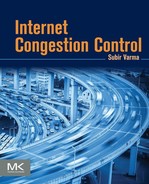Table of Contents
1.2 Basics of Congestion Control
1.4 Network Feedback Techniques
1.5 Delay-Based Congestion Control: TCP Vegas
1.6 Outline of the Rest of the Book
Chapter 2. Analytic Modeling of Congestion Control
2.3 A Fluid Flow Model for Congestion Control
2.4 A Stochastic Model for Congestion Control
2.5 Why Does the Square-Root Formula Work Well?
2.6 The Case of Multiple Parallel TCP Connections
Appendix 2.A Derivation of Q=min(1,3/E(W))
Chapter 3. Optimization and Control Theoretic Analysis of Congestion Control
3.2 Congestion Control Using Optimization Theory
3.3 Generalized TCP–Friendly Algorithms
3.4 Stability Analysis of TCP with Active Queue Management
3.5 The Averaging Principle (AP)
3.6 Implications for Congestion Control Algorithms
Appendix 3.A Linearization of the Fluid Flow Model
Appendix 3.B The Nyquist Stability Criterion
Appendix 3.C Transfer Function for the RED Controller
Appendix 3.D Convex Optimization Theory
Chapter 4. Congestion Control in Broadband Wireless Networks
4.2 Wireless Access Architecture and Issues
4.4 Algorithms to Improve Performance Over Lossy Links
4.5 Link-Level Error Correction and Recovery
4.6 The Bufferbloat Problem in Cellular Wireless Systems
Chapter 5. Congestion Control in High-Speed Networks
5.2 Design Issues for High-Speed Protocols
5.3 High Speed TCP (HSTCP) Protocol
5.5 The Compound TCP (CTCP) Protocol
5.7 The eXpress Control Protocol (XCP)
5.8 The Rate Control Protocol (RCP)
5.9 Stability of High-Speed TCP Algorithms
Chapter 6. Flow Control for Video Applications
6.2 Video Delivery Over Packet Networks
6.3 HTTP Adaptive Streaming (HAS)
6.4 The Adaptive Bit Rate (ABR) Algorithm
6.5 Description of Some Adaptive Bit Rate (ABR) Algorithms
6.6 The Problem with TCP Throughput Measurements
6.7 Interaction Between TCP and ABR
Chapter 7. Congestion Control in Data Center Networks
7.2 Data Center Architecture and Traffic Patterns
7.4 Deadline-Aware Congestion Control Algorithms
7.5 Load Balancing over Multiple Paths with Multipath TCP (MPTCP)
7.6 The Incast Problem in Data Center Networks
Chapter 8. Congestion Control in Ethernet Networks
8.2 Differences between Switched Ethernet and IP Networks
8.3 Objectives of the Quantum Congestion Notification Algorithm
8.4 Quantum Congestion Notification Algorithm Description
8.5 Quantum Congestion Notification Stability Analysis
Chapter 9. Emerging Topics in Congestion Control
9.2 Machine Learning and Congestion Control: Project Remy
9.3 Software Defined Networks and Congestion Control
